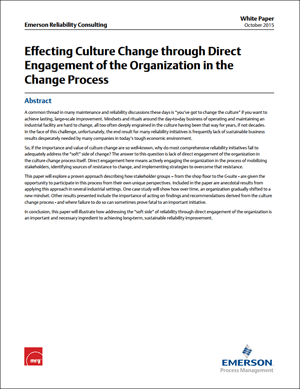 Fear of change is often the leading obstacle of progress. For process manufacturers and producers, reliability-centered maintenance concepts have been around since the 1970s. Technology advancements in sensors and wireless communications have vastly improved the technology side of maintenance and reliability initiatives, but the organizational workflow and cultures have limited their successes.
Fear of change is often the leading obstacle of progress. For process manufacturers and producers, reliability-centered maintenance concepts have been around since the 1970s. Technology advancements in sensors and wireless communications have vastly improved the technology side of maintenance and reliability initiatives, but the organizational workflow and cultures have limited their successes.
Some of these “soft side” issues include:
- Lack of leadership support.
- Changes in management.
- Embedded culture of resistance.
- Lack of communication.
- Poor understanding of the need for change.
- Poor understanding of the benefits of change.
- Lack of persistence.
- Limited resources in money, time, people.
- Poor teamwork.
- Inadequate training.
A successful maintenance and reliability initiative engages:
…the organization in the human side of the change process leaves much less to chance, therefore giving the initiative a greater opportunity for success. Here, not only are the key elements required for successful change considered and deliberate actions taken around them, but ownership and active participation in the change process itself is built among stakeholders. The result is a greater commitment by the organization as a whole for the change, one that is much less likely to be unraveled by circumstances beyond immediate control.
Key elements in navigating the change management process include:
Leadership1. Everyone knows how difficult it is to accomplish a major change without the full support of upper management. For a comprehensive maintenance and reliability improvement initiative, the role of management is critical in many ways. For example, leadership must ensure the provision of necessary resources and guide the effort. Leadership must also build and maintain a sense of urgency in the organization for the change. A mandate from leadership can provide some motivation in the workforce, but just as important is the consistent, persistent message that the change is both necessary and important.
The Case for Change2. Sometimes referred to as the “burning platform”, the case for change must be clearly articulated. It should be much more than a financial business case and should incorporate different stakeholder perspectives. In the context of reliability, there is typically a compelling financial justification. But the case for change must also be seen and felt on a personal level by key stakeholders. In other words, it should help answer the question “what’s in it for me?” as seen from each stakeholder groups’ unique point of view.
Vision1. What the future state will look like must be well-defined before the goals, objectives, and activities designed to achieve them can be determined. Like the case for change, the vision should incorporate different perspectives of the stakeholders. Project Plan. This is the technical part of the project outlining what is in-scope in terms of technology, business processes, skills, and infrastructure for the change to be successful. The project plan should be clear and understood by key constituents who may be assisting in its implementation and who may end up living with the final product.
Overcoming Resistance. The force for change must be generated to exceed the force of resistance. Helping lagging elements of the organization through the “valley of despair” should not be left to chance. Strategies must be developed and plans implemented targeting key stakeholder groups – and sometimes even individuals – based on types of resistance and personal “wins”.
Making it Stick2. Careful attention should be paid to targeted activities such as celebrating short-term wins, ensuring adequate resources are available, and setting up effective reward systems to help maintain enthusiasm and momentum in the organization and make it less likely that the initiative can be unraveled. Ownership of these activities by teams within the organization will make it more likely that positive results can be sustained over time.
Read the whitepaper for ideas on organizational engagement in the change process and some examples of this process put into action at three municipal treatment plants.
You can connect and interact with other reliability and maintenance experts in the Maintenance & Reliability group in the Emerson Exchange 365 community.
1Stephen J. Thomas, Improving Maintenance & Reliability Through Cultural Change, Industrial Press, 2005
2John P. Kotter, The Heart of Change, Harvard Business School Publishing, 2002

